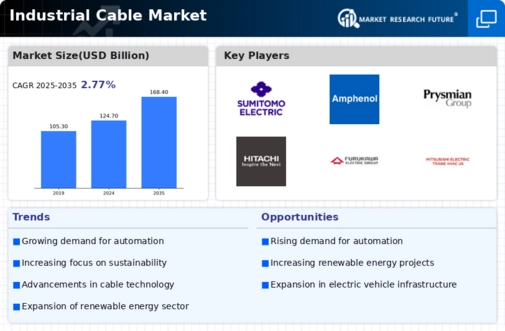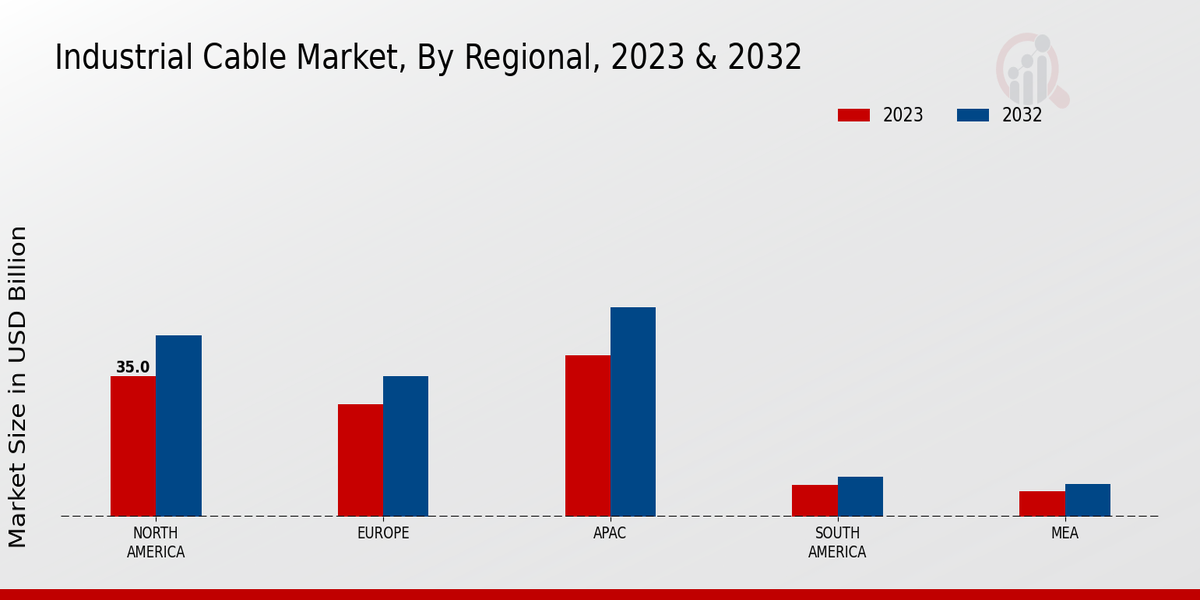Market Growth Projections
The Global Industrial Cable Market Industry is projected to reach a value of 124.7 USD Billion in 2024, with expectations to grow to 168.4 USD Billion by 2035. This growth trajectory reflects a compound annual growth rate (CAGR) of 2.77% from 2025 to 2035. The increasing demand for industrial cables across various sectors, including energy, telecommunications, and manufacturing, underpins these projections. As industries evolve and expand, the need for reliable and efficient cabling solutions is likely to remain a driving force in the market.
Increased Automation in Industries
The trend towards increased automation in manufacturing and industrial processes significantly impacts the Global Industrial Cable Market Industry. As industries adopt automation technologies such as robotics and IoT, the need for reliable and efficient cabling solutions becomes critical. Industrial cables must support high-speed data transmission and withstand the rigors of automated environments. For example, factories implementing smart manufacturing systems require specialized cables to connect sensors, actuators, and control systems. This shift towards automation is likely to sustain market growth, as businesses seek to enhance productivity and operational efficiency.
Rising Demand for Renewable Energy
The Global Industrial Cable Market Industry experiences a notable increase in demand driven by the transition towards renewable energy sources. As countries globally invest in solar, wind, and hydroelectric power, the need for specialized industrial cables that can withstand harsh environmental conditions becomes paramount. For instance, the installation of offshore wind farms necessitates robust cabling solutions to ensure efficient energy transmission. This trend is reflected in the projected market value of 124.7 USD Billion in 2024, indicating a strong growth trajectory as industries adapt to sustainable practices.
Infrastructure Development Initiatives
Infrastructure development initiatives across various regions are a critical driver for the Global Industrial Cable Market Industry. Governments worldwide are investing heavily in upgrading and expanding their infrastructure, including transportation, telecommunications, and utilities. For instance, the construction of smart cities and the modernization of electrical grids require extensive cabling solutions to support advanced technologies. This surge in infrastructure projects contributes to the anticipated market growth, with projections indicating a rise to 168.4 USD Billion by 2035. Such investments not only enhance connectivity but also stimulate economic growth, further driving demand for industrial cables.
Growing Focus on Safety and Compliance Standards
The Global Industrial Cable Market Industry is also influenced by the growing emphasis on safety and compliance standards across various sectors. Regulatory bodies are increasingly mandating stringent safety requirements for electrical installations, particularly in industries such as construction, oil and gas, and manufacturing. Compliance with these standards necessitates the use of high-quality industrial cables that meet specific safety criteria. For instance, cables designed for hazardous environments must adhere to rigorous testing and certification processes. This focus on safety not only protects workers but also drives demand for compliant cabling solutions, thereby supporting market growth.
Technological Advancements in Cable Manufacturing
Innovations in cable manufacturing technologies significantly influence the Global Industrial Cable Market Industry. The introduction of advanced materials and production techniques enhances the performance and durability of industrial cables. For example, the development of high-temperature superconductors and improved insulation materials allows for greater efficiency in energy transmission. These advancements not only reduce energy losses but also extend the lifespan of cables, thereby lowering maintenance costs. As a result, the market is expected to grow steadily, with a projected CAGR of 2.77% from 2025 to 2035, reflecting the industry's adaptability to technological progress.











